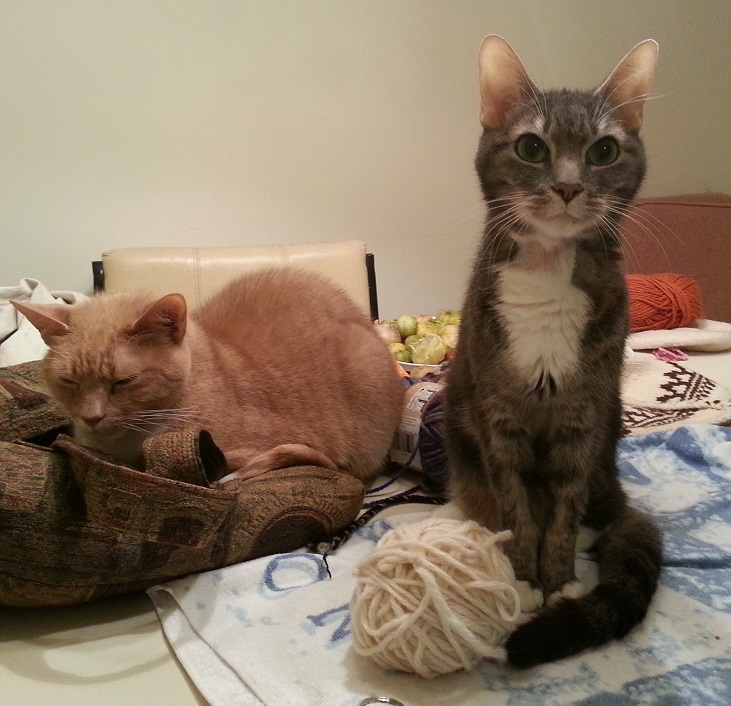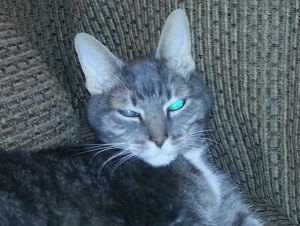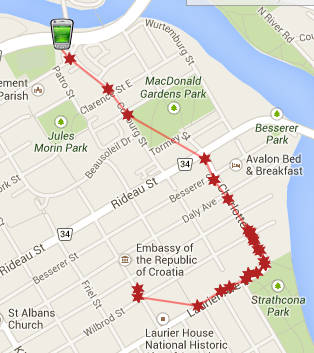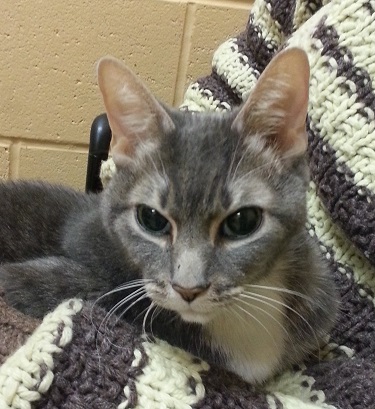I know it’s Ottawa and it’s March and I shouldn’t be whining about the weather, but really, the sight that greeted me from my window this morning was a bit of a shock on March 30.

Enough already!
I know it’s Ottawa and it’s March and I shouldn’t be whining about the weather, but really, the sight that greeted me from my window this morning was a bit of a shock on March 30.

Enough already!
25 or so years ago, a mutual friend introduced me to Karoly (Charles) Grandpierre, a struggling Ottawa artist of Hungarian extraction. “Pierre”, as his friends knew him, finished his studies at the Ottawa School of Arts and was trying to make a living as a painter. The friend who introduced us died the following year in a tragic car accident. Although we didn’t really stay in touch, I never completely lost track of Pierre, as there were other mutual friends who from time to time told us about him. That’s how we learned, for instance, that eventually he moved back to Hungary.
Well, Pierre is no more. I just read that he passed away last week, at age 65, after a prolonged battle with cancer.
Second Tuesday of the month. Not my favorite day.
This is when Microsoft releases their monthly batch of updates for Windows.
And this is usually when I also update other software, e.g., Java, Flash, Firefox, on computers that I do not use every day.
Here is about half of them.
The other half sit on different desks.
Oh, that big screen, by the way, is shared by four different computers. Fortunately, two of them are Linux servers. Not that they don’t require updating, but those updates do not usually come on the second Tuesday of the month.
Our sick kittycat, Szürke, is a little less sick today.
Make that a lot less sick, actually.
Anemia is measured by what is called the Packed Cell Volume (PCV), basically the percentage of the volume of red blood cells vs. the total volume of blood. For a cat, the normal range for PCV starts in the mid-20s. When we thought we were saying good-bye to Szürke back in October, his PCV went down all the way to the incredibly low value of 7, which for all practical intents and purposes is a near-death experience. It was equivalent to trying to breathe on top of Mount Everest.
Today, Szürke’s PCV was 28. This value, an increase of about 4.5 since six days ago, was achieved despite the fact that we discontinued the erythropoietin hormone treatment that is supposed to stimulate his bone marrow and help with red blood cell production. This means that Szürke is back in the low normal range.
We shall see how things unfold in the coming weeks. The vet warned us that as the erythropoietin wears off, his red blood cell count will likely start to drop again. But if we can maintain it at a healthy level with continuing hormone treatments…
Time will tell. For now, we celebrate Szürke’s astonishing recovery.

 The other night, I was tired and needed a distraction. I happened upon on online IQ test and decided to take it out of curiosity.
The other night, I was tired and needed a distraction. I happened upon on online IQ test and decided to take it out of curiosity.
I scored well. How well exactly, I do not know because once the test was over, there was another, bonus question: they asked for my credit card number as a means to pay for a detailed report.
I realized that this really was the last of the intelligence test questions.
I passed the test. I did not pay good money just to get a report about how intelligent I am.
Boy, I am ever so smart!
This is what my car told me this morning:
Yes, it needed a new battery. It just wouldn’t start.
The irony is that my car is a hybrid. Which means that when you turn the key, it usually just comes to life, like any decent electric motor would. And behind the back seat, there is a 144 V NiMH battery with enough juice to light up my house. But when the outside temperature is low, the engine computer decides on its own that the engine should be cranked like a low-tech gasoline engine… from the 12 V battery, using an ordinary starter motor. And when that happens in the dead of a Canadian winter, with a battery that was last replaced about six years ago…
Thank goodness for Canadian Tire.
The video, by the way, is a scene from Return to Zork, the first multimedia sequel to the classic Zork series of text adventure games from the early 1980s. The graphics may be a tad dated, but the game is still quite good and entertaining… and plays well in DOSBox.
Poppy is a 20th century cat.

Not for the first time, Poppy is a guest in our house, while her owner is traveling during the holidays. Poppy was a shelter cat. Her owner acquired Poppy in 2000, when the cat was around one year old.
Poppy is a beautiful cat. The first day after her arrival, she was hissing and growling a lot, but she acclimatized rapidly, and has been very friendly since. She is also tolerating our other cats reasonably well.
It was so good to see this old friend in good health, and in such good shape. The number of cats around who were born in the 20th century is dwindling rapidly. Cats may live longer than dogs, but they don’t live forever, and a 15-year old cat is certainly considered a senior. If Poppy were human, she would definitely qualify for a discount bus pass.
That said, I hope we will have many more chances to welcome Poppy in our home in the years to come.
For the first time in years, I was able to add a truly new (to me) programmable calculator to my Web museum: the Casio FM-300. What a delightful find!
Our cat Szürke is not only still with us, but his condition continues to improve. This is no small Christmas miracle. Made possible, well, by modern veterinary science and the money spent to pay for it, but also by the caring of veterinarians and their staff at Beechwood Animal Hospital (our “local” vet) and Alta Vista Animal Hospital (where Szürke received numerous transfusions and emergency care.)
Year after year, as Christmas Eve nears, I recall the Christmas message of Apollo 8 astronaut Frank Borman. Here is what he said in 1968, 45 years ago: “And from the crew of Apollo 8, we close with good night, good luck, a Merry Christmas and God bless all of you – all of you on the good Earth.”
Amen.

Here are two kittycats, Kifli (left) and Szürke. Szürke is the cat who caused us many a sleepless night in the past two months, with his mysterious anaemia.

The good news is that he is holding steady, now nearly three weeks since his last transfusion. His red blood cell count is still not recovering the way it should, but we may have arrested the loss. My fingers remain firmly crossed.
Hard to believe but back in his heyday, Szürke was significantly heavier than his brother.
 When you have a family member who is gravely ill, you may not have the stamina to pay attention to other things. When you have a family pet that is gravely ill, it’s almost as bad (actually, in some ways it’s worse, as a pet cannot tell what hurts and you cannot explain to the pet why unpleasant medication is necessary or discuss with the pet the available treatment options.)
When you have a family member who is gravely ill, you may not have the stamina to pay attention to other things. When you have a family pet that is gravely ill, it’s almost as bad (actually, in some ways it’s worse, as a pet cannot tell what hurts and you cannot explain to the pet why unpleasant medication is necessary or discuss with the pet the available treatment options.)
As I’ve been dealing with a gravely ill cat in the past six weeks, I neglected to pay attention to other things.
I did not add a blog entry on October 31 with my drawing of a Halloween cat.
I did not comment on Remembrance Day. I am very fond of Remembrance Day, because it does not celebrate victory nor does it glorify war; on the contrary, it celebrates sacrifice and laments on the futility of war. This is why I am so unimpressed by the somewhat militantly pacifist “white poppy” campaign; in my view, they completely miss the point. I usually put a stylized poppy in my blog on November 11; not this year, as I spent instead a good portion of that day and the next at the vet.
I most certainly did not comment on that furious (and infuriating) wild hog of a mayor, Toronto’s Rob Ford, or for that matter, the other juicy Canadian political scandal, the Senate expense thing. That despite the fact that for a few days, Canadian news channels were actually exciting to watch (a much welcome distraction in my case), as breaking news from Ottawa was interrupted by breaking news from Toronto or vice versa.
I also did not blog about the continuing shenanigans of Hungary’s political elite, nor the fact that an 80-year old Hungarian writer, Akos Kertesz (not related to Imre Kertesz, the Nobel-laureate) sought, and received, political asylum, having fled Hungary when he became the target of threats and abuse after publishing an article in which he accused Hungarians of being genetically predisposed to subservience.
Nor did I express my concern about the stock market’s recent meteoric rise (the Dow Jones index just hit 16,000) and whether or not it is a bubble waiting to be burst.
And I made no comments about the horrendous typhoon that hit the Philippines, nor did I wonder aloud what Verizon Canada must be thinking these days about their decision to move both their billing and their technical support to that distant country.
Last but certainly not least, I did not write about the physics I am trying to do in my spare time, including my attempts to understand better what it takes for a viable modified gravity theory to agree with laboratory experiments, precision solar system observations, galactic astronomy and cosmological data sets using the same set of assumptions and parameters.
Unfortunately, our cat remains gravely ill. The only good news, if it can be called that, is that yesterday morning, he vomited a little liquid and it was very obviously pink; this strongly suggests that we now know the cause of his anaemia, namely gastrointestinal bleeding. We still don’t know the cause, but now he can get more targeted medication. My fingers remain crossed that his condition is treatable.
 Our cat Szürke remains gravely ill and I don’t know if he will make it.
Our cat Szürke remains gravely ill and I don’t know if he will make it.
About two years ago, he was diagnosed with hyperthyroidism, a not altogether uncommon disease among older cats. At the time, we opted to treat his condition with medication (Tapazole); the alternative would have been radiological treatment, which works well but would have required him to spend a long time (couple of weeks, we were told at the time) in quarantine.
Szürke has been doing well although lately, he has been losing weight.
Then, on Sunday October 6, he started vomiting. Occasionally throwing up a furball is not exactly a problem with most cats. Vomiting a clear, foamy liquid eight times in an hour is.
The next day, we took Szürke to our local vet who diagnosed him with renal failure, noted that he was dehydrated, and his T4 level was also very low. We discontinued the Tapazole. Even more alarmingly, he was becoming a little anaemic, with a PCV level of 20 (normal, I believe, is between 30 and 50).
We brought Szürke home. He was doing okay, though his appetite was not great. A week later, on October 16, we went back to the vet for a recheck. The vet became very alarmed when Szürke’s PCV level was measured at 15. She immediately recommended that we take him to Alta Vista Animal Hospital, where he would get a transfusion.
Szürke spent two days at Alta Vista. When we brought him home, the diagnosis was still largely unchanged: the anaemia was believed to have been caused by advanced renal failure. The only thing odd was that his renal values were really not that bad. On the other hand, an ultrasound examination showed no other abnormalities that could have been responsible for his condition.
We brought Szürke home on Friday, October 18, with a prescription for Eprex, a subcutaneous injection that was supposed to stimulate his bone marrow and help him produce red blood cells. Szürke got his first injection on Saturday, but we never got to the second two days later, as by that time, Szürke stopped eating altogether. So instead of injecting him, I took him back to Alta Vista.
This time around, Szürke spent four days at the hospital. He received two more transfusions, as his PCV levels dropped to alarmingly low levels (the lowest, I believe, was 7.) On Tuesday, October 22, we actually visited him late at night, thinking that this was probably good-bye.
By this time, however, the diagnosis was different. For starters, a detailed blood test showed that his anaemia is likely regenerative: his reticulocyte count was higher than normal, in fact. I actually viewed this as both a ray of hope and as a message of sorts: if his little body has not yet given up fighting, how can I give up on him?
So the question then, was this: is his regenerative anaemia anemia due to a haemorrhage or haemolysis?
There were no obvious signs of haemorrhage. There was no blood in his vomit or his stool (though my wife and I noticed, and brought to the vet’s attention, that his stools were significantly darker than normal.) So the doctor’s first bet was that the anaemia is haemolytic, due either to an infection or an autoimmune condition. A biopsy was non-conclusive but it indicated a possible minor gastrointestinal infection. Still, the doctors were leaning towards an autoimmune condition as a more likely explanation.
I brought Szürke home on the 25th of October, with prescriptions for Prednisone, Omeprazole, potassium gluconate, Metronidazole and Sulcrate. He was also back on Tapazole, albeit at a much reduced dose. His PCV level after his last transfusion was 17. Yet three days later, when I took him back for a recheck appointment, his PCV was down to 12. At this time, after discussions with the doctor, we opted to discontinue to the Tapazole altogether, betting on the possibility that the autoimmune response was due to sensitivity to this medication. The Sulcrate was also discontinued (he responded very badly to my attempts to administer this liquid medication.) On the other hand, he began receiving cyclosporine in liquid form.
Nonetheless the next day, his PCV levels were further down, to 10, and he was vomiting, so I took him back to Alta Vista for his fourth transfusion. With his PCV back at 13, I brought him home. Two days later, on October 31, we went for a recheck and, surprise: his PCV was up to 17! Finally, some real hope, we thought. Also at this time, the liquid cyclosporin was discontinued in favor of a capsule, which was much easier to administer.
We were okay for a few days. The next visit was on Friday, November 4. By then, Szürke’s PCV was up to 20! However, his T4 levels were going through the roof, due to his untreated thyroid condition. On the vet’s advice, we began to give him an appetite stimulant (Mirtazapine) in the hope that this will be sufficient to make him eat a special, low-iodine diet (Hill’s Y/D) which would allow us to control his thyroid without medication.
For a few days, all seemed to go well but then his appetite dropped, despite the Mirtazapine. On November 11, I took Szürke to our local vet, who checked his PCV: a disastrous 11. I immediately discontinued the Y/D diet and started giving him whatever he liked… the thinking was that if these were to be his last few days on Earth, I won’t try to starve him with food he wouldn’t eat, and if there is still hope, the thyorid is a long-term concern, whereas the anaemia can kill him in days.
The next day, I discussed all this with the vet at Alta Vista who suggested another possible treatment: Chlorambucil (medication so dangerous, I’m advised to wear rubber gloves when handling the capsules. Scary.) The vet also reluctantly recommend another transfusion. By the time we got to Alta Vista, Szürke’s PCV was down to 9. When I brought him home very late at night, it was back to 12 as a result of the transfusion.
That was two days ago. Szürke is home today, and seemingly doing well. But that has always been the case; even when he was weak as a kitten, his happy disposition never changed, he never ceased being playful, never even stopped grooming himself.
He is eating moderately well. He is interested in the world around him. He is still accepting his medications without too much trouble.
But we still don’t really know what on Earth is wrong with him in the first place. So we are left with taking things one day at a time. I have no idea what tomorrow will bring.
 I have been collaborating with John Moffat on his modified gravity theory and other topics since 2007. It has been an immensely rewarding experience.
I have been collaborating with John Moffat on his modified gravity theory and other topics since 2007. It has been an immensely rewarding experience.
John is a theoretical physicist who has been active for sixty years. During his amazingly long career, John met just about every one of the iconic figures of 20th century physics. He visited Erwin Schrödinger in a house where Schrödinger lived with his wife and his mistress. He was mentored by Niels Bohr. He studied under Fred Hoyle (the astronomer who coined the term “Big Bang”). He worked under Paul Dirac. He shared office space with Peter Higgs. He took Wolfgang Pauli out for a wet lunch on university funds. He met Feynman, Oppenheimer, and many others. The one iconic physicist Moffat did not meet in person was Albert Einstein; however, Einstein still played a pivotal role in his career, answering letters written to him by a young John Moffat (then earning money as a struggling artist) encouraging him to continue his studies of physics.
Though retired, John remains active as a member of the prestigious Perimeter Institute in Waterloo. I don’t expect him to run out of maverick ideas anytime soon. Rare among physicists his age, John’s knowledge of the science is completely up-to-date, as is his knowledge of the tools of the trade. I’ve seen physicists 20 years his junior struggling with hand-written transparencies (remember those, and the unwieldy projectors?) even as John was putting the finishing touches to his latest PowerPoint presentation on his brand new laptop or making corrections to a LaTeX manuscript.
More recently, John began to write for a broader audience. He already published two excellent books. His first, Reinventing Gravity, describes John’s struggle to create a viable alternative to Einstein’s General Theory of Relativity, a new gravity theory that would explain mysteries such as the rotation of galaxies without resorting to the dark matter hypothesis. John’s second book, Einstein Wrote Back, is a personal memoir, detailing his amazing life as a physicist.
John’s third book, which is about to be published, is perhaps his most ambitious book project yet. Cracking the Particle Code, published by the prestigious Oxford University Press, is about the decades of research in particle physics that resulted in the recent discovery of what is believed to be the elusive Higgs boson, and John’s attempts to explore theoretical alternatives that might make the Higgs boson hypothesis unnecessary, and provide alternative explanations for the particle observed by the Large Hadron Collider.
I had the good fortune of being able to read the manuscript earlier this year. My first reaction was that John took up an almost impossible task. As many notable physicists, including Einstein, observed, quantum physics is harder, perhaps much harder, than relativity theory. The modern Standard Model of particle physics combines the often arcane rules of quantum field theory with a venerable zoo of particles (12 fermions and their respective antiparticles, four vector bosons, eight gluons and, last but not least, the Higgs boson). Though the theory is immensely successful, it is unsatisfying in many ways, not the least because it fails to account for perhaps the most fundamental interaction of all: gravity. And its predictions, while exact, are very difficult to comprehend even for trained theorists. Reducing data on billions of collisions in a large accelerator to definitive statements about, say, the spin and parity of a newly observed particle is a daunting challenge.
Explaining all this in a form that is accessible to the interested but non-professional reader is the task that John set out to tackle. His text mixes a personal narrative with scientific explanations of these difficult topics. To be sure, the technical part of the text is not an easy read. This is not John’s fault; the topic is very difficult to understand unless you are willing to invest the time and effort to study the mathematics. But John’s personal insights perhaps make the book enjoyable even to those who choose to skip over the more technical paragraphs.
There are two points in particular that I’d like to mention in praise. First, John’s book is amazingly up-to-date; as late as a few weeks ago, John was still making small corrections during the copy editing process to ensure that everything he says is consistent with the latest results from CERN. Second, John’s narrative always makes a clear distinction between standard physics (i.e., the “consensus”) and his own notions. While John is clearly passionate about his ideas, he never forgets the old adage attributed to the late US Senator, Daniel Patrick Moynihan: John knows that he is only entitled to his own opinions, he is not entitled to his own facts, and this is true even if the facts invalidate a theoretical proposal.
I hope John’s latest book sells well. I hope others will enjoy it as much as I did. I certainly recommend it wholeheartedly.
I just spent a small
Fortune at the vet,
And all I got to bring home
Is this lousy cat.

Our cat Szürke’s packed cell volume (PCV) is up this morning. A ray of hope. Dare we hope? Or is it just that roller coaster thing again, and his PCV might come crashing down over the weekend, as it did before? If that happens, we’re really out of options.
My wife took the #7 bus yesterday on her way home from the Byward Market.
The bus had to take a detour, due to the ongoing construction on Rideau street.
Then it had to take a further detour, perhaps due to the construction, maybe some other reason (an accident?)
When I spoke to her, the bus was standing still on Chapel street, heading in the wrong direction.
Some 20 minutes later, when the bus was already on Laurier, I turned on continuous GPS tracking of her phone. Tracking information was collected roughly every minute.

All in all, it took her approximately 45 minutes to get home from the intersection of Chapel and Wilbrod streets.
According to Google Maps, the distance is 950 meters on foot, and it would have take 12 minutes to get home walking. Unfortunately, she had some heavy bags with her so walking was not really an option. Although, had she known what was about to happen, she could have gotten off the bus at Besserer and Chapel, only a 700 meter walk from home.
Construction season is so much fun.
Our second oldest cat, Szürke (his name means gray in Hungarian, as he is a gray tabby; but we often just call him Süsü, which means something like silly, because he’s a silly little lapcat), is gravely ill. (As is my bank account as a result of the veterinary expenses, but that is another story.)
Trouble is, we don’t know what’s wrong with him.
He has hyperthyroidism, that much we know; he has been getting medication for that for a couple of years already.
But most recently, he became severely anemic. The doctors at first suspected renal failure. But that does not seem to be the case. The problem is more acute, perhaps some gastrointestinal bleeding. Yet still, there is no obvious cause, hence no obvious treatment.
His red cell count keeps dropping. We visited him tonight in the veterinary hospital. We are prepared for the possibility that this was good-bye.

But we have not yet given up hope.
 Here is a sight I have not seen since July 30:
Here is a sight I have not seen since July 30:
Route results for 199.166.252.0/24 from Vienna, Austria
BGP routing table entry for 199.166.252.0/24
Paths: (4 available, best #1)
1239 577
AS-path translation: { AS1239 BELL-AS }
edge3.Frankfurt1 (metric 13114)
Origin IGP, metric 100000, localpref 86, valid, internal, best
Community: Europe Lclprf_86 Germany Level3_Peer Frankfurt
Originator: edge3.Frankfurt1
1239 577
AS-path translation: { AS1239 BELL-AS }
edge3.Frankfurt1 (metric 13114)
Origin IGP, metric 100000, localpref 86, valid, internal
Community: Europe Lclprf_86 Germany Level3_Peer Frankfurt
Originator: edge3.Frankfurt1
1239 577
AS-path translation: { AS1239 BELL-AS }
edge3.Frankfurt1 (metric 13114)
Origin IGP, metric 100000, localpref 86, valid, internal
Community: Europe Lclprf_86 Germany Level3_Peer Frankfurt
Originator: edge3.Frankfurt1
1239 577
AS-path translation: { AS1239 BELL-AS }
edge3.Frankfurt1 (metric 13114)
Origin IGP, metric 100000, localpref 86, valid, internal
Community: Europe Lclprf_86 Germany Level3_Peer Frankfurt
Originator: edge3.Frankfurt1
This is a valid routing table entry for my class C address space at a randomly picked backbone router somewhere on the Internet.
On July 30, Verizon Canada disconnected me. Or rather, they decommissioned the point-of-presence equipment that was utilized by my Internet connection, without moving all their customers first to another POP.
When Verizon proved unable to restore my connection after 10 (!) days, I canceled my contract with them. Meanwhile, my sites’ continuing existence on the Internet was maintained using a backup cable modem connection.
But, as of today, I once again have a functioning DSL connection, courtesy of Bell Canada. Better yet, they were actually able to set up everything properly, including my special request for routing for my portable class C address space. Needless to say, I am very pleased.
And their service costs a lot less than Verizon Canada’s.